
Herrerasauridae is a family of carnivorous dinosaurs, possibly basal to either theropods or even all of saurischians, or even their own branching from Dracohors, separate from Dinosauria altogether. They are among the oldest known dinosaurs, first appearing in the fossil record around 233.23 million years ago, before becoming extinct by the end of the Carnian stage. Herrerasaurids were relatively small-sized dinosaurs, normally no more than 4 metres (13 ft) long, although the holotype specimen of "Frenguellisaurus ischigualastensis" is thought to have reached around 6 meters long. The best known representatives of this group are from South America, where they were first discovered in the 1930s in relation to Staurikosaurus and 1960s in relation to Herrerasaurus. A nearly complete skeleton of Herrerasaurus ischigualastensis was discovered in the Ischigualasto Formation in San Juan, Argentina, in 1988. Less complete possible herrerasaurids have been found in North America and Africa, and they may have inhabited other continents as well.
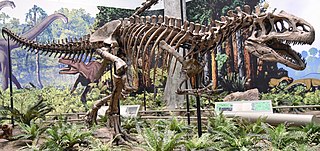
Allosauridae is a family of medium to large bipedal, carnivorous allosauroid theropod dinosaurs from the Late Jurassic. Allosauridae is a fairly old taxonomic group, having been first named by the American paleontologist Othniel Charles Marsh in 1878. Allosaurids are characterized by an astragalus with a restriction of the ascending process to the lateral part of the bone, a larger medial than lateral condyle, and a horizontal groove across the face of the condyles.

Darren William Naish is a British vertebrate palaeontologist, author and science communicator.
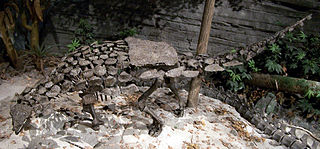
Nodosauridae is a family of ankylosaurian dinosaurs, from the Late Jurassic to the Late Cretaceous period in what is now North America, South America, Europe, and Asia.

Dinogorgon is a genus of gorgonopsid from the Late Permian of South Africa and Tanzania. The generic name Dinogorgon is derived from Greek, meaning "terrible gorgon", while its species name rubidgei is taken from the surname of renowned Karoo paleontologist, Professor Bruce Rubidge, who has contributed to much of the research conducted on therapsids of the Karoo Basin. The type species of the genus is D. rubidgei.

Palaeontology is one of the two scientific journals of the Palaeontological Association. It was established in 1957 and is published on behalf of the Association by Wiley-Blackwell. The editor-in-chief is Dr Paul Taylor. Palaeontology publishes articles on a range of palaeontological topics, including taphonomy, functional morphology, systematics, palaeo-environmental reconstruction and biostratigraphy. According to the Journal Citation Reports, the journal has a 2021 impact factor of 3.547, ranking it 3rd out of 54 journals in the category "Paleontology".

Zhejiangosaurus is an extinct genus of ankylosaurian dinosaur from the Upper Cretaceous of Zhejiang, eastern China. It was first named by a group of Chinese authors Lü Junchang, Jin Xingsheng, Sheng Yiming and Li Yihong in 2007 and the type species is Zhejiangosaurus lishuiensis. It has no diagnostic features, and thus is a nomen dubium.

Testudinata is the group of all tetrapods with a true turtle shell. It includes both modern turtles (Testudines) and many of their extinct, shelled relatives (stem-turtles), though excluding Odontochelys and Eorhynchochelys, which are placed in the more inclusive Pantestudines.
Sam W. Heads is a British palaeontologist, a Fellow of the Linnean Society of London, a Fellow of the Royal Entomological Society, as well as a former Officer and Editor-in-Chief at the Orthopterists' Society.
Paleontology or palaeontology is the study of prehistoric life forms on Earth through the examination of plant and animal fossils. This includes the study of body fossils, tracks (ichnites), burrows, cast-off parts, fossilised feces (coprolites), palynomorphs and chemical residues. Because humans have encountered fossils for millennia, paleontology has a long history both before and after becoming formalized as a science. This article records significant discoveries and events related to paleontology that occurred or were published in the year 2010.
Milleropsis is an extinct genus of millerettid parareptile from the Late Permian of South Africa.
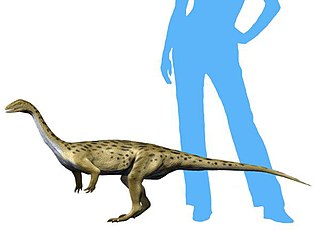
Saturnaliidae is a family of basal sauropodomorph dinosaurs found in Brazil, Argentina and possibly Zimbabwe. It is not to be confused with Saturnalidae, a family of radiolarian protists.
Paleontology or palaeontology is the study of prehistoric life forms on Earth through the examination of plant and animal fossils. This includes the study of body fossils, tracks (ichnites), burrows, cast-off parts, fossilised feces (coprolites), palynomorphs and chemical residues. Because humans have encountered fossils for millennia, paleontology has a long history both before and after becoming formalized as a science. This article records significant discoveries and events related to paleontology that occurred or were published in the year 2012.

Scincogekkonomorpha is a proposed clade of lizards that includes scleroglossans and all lizards more closely related to scleroglossans than to iguanians. These "stem" scleroglossans include extinct lizards from the Late Jurassic and Early Cretaceous such as Bavarisaurus, Eichstaettisaurus, Liushusaurus, and Scandensia. Scincogekkonomorpha was named in 1961 and is now occasionally used as a stem-based taxon in contrast to the node-based taxon Scleroglossa. According to phylogenies based on morphological characteristics, Scincogekkonomorpha is the sister taxon of Iguania and together they make up crown group Squamata, the smallest clade including all living snakes and lizards. The grouping has not been recovered as monophyletic in recent molecular studies, with Iguania generally found deeply nested within Squamata.

Laosuchus is an extinct genus of chroniosuchian known from the Permian-Triassic boundary of Asia. Two species have been named.

Hegetotherium is an extinct genus of mammals from the Early to Middle Miocene of South America. Fossils of this genus have been found in the Cerro Bandera, Cerro Boleadoras, Chichinales, Collón Curá, Santa Cruz and Sarmiento Formations of Argentina, the Nazareno Formation of Bolivia, and the Galera and Río Frías Formations of Chile.

Niebla is a genus of abelisaurid theropod dinosaur from the Late Cretaceous Period (Campanian-Maastrichtian) of Río Negro province, Argentina. The genus contains a single species, Niebla antiqua, and is known from a partial, non-articulated skeleton. The holotype, found in the Allen Formation, represents an adult individual.
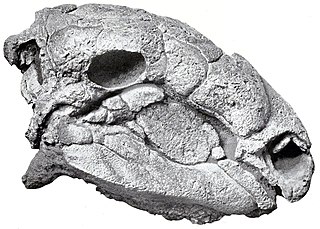
Panoplosaurini is a clade of nodosaurid ankylosaurs from the Cretaceous of North America and South America. The group is defined as the largest clade containing Panoplosaurus mirus, but not Nodosaurus textilis or Struthiosaurus austriacus, and was named in 2021 by Madzia and colleagues for the group found in many previous analyses, both morphological and phylogenetic. Panoplosaurini includes not only the Late Cretaceous Panoplosaurus, Denversaurus and Edmontonia, but also the mid Cretaceous Animantarx and Texasetes, as well as Patagopelta. However, in the study describing it, its authors only placed it as a nodosaurine outside Panoplosaurini. The approximately equivalent clade Panoplosaurinae, named in 1929 by Franz Nopcsa, but was not significantly used until Robert Bakker reused the name in 1988, alongside the new clades Edmontoniinae and Edmontoniidae, which were considered to unite Panoplosaurus, Denversaurus and Edmontonia to the exclusion of other ankylosaurs. As none of the clades were commonly used, or formally named following the PhyloCode, Madzia et al. named Panoplosaurini instead, as the group of taxa fell within the clade Nodosaurinae, and having the same -inae suffix on both parent and child taxon could be confusing in future. The 2018 phylogenetic analysis of Rivera-Sylva and colleagues was used as the primary reference for Panoplosaurini by Madzia et al., in addition to the supplemental analyses of Arbour et al. (2016), Brown et al. (2017), and Zheng et al. (2018).
Westralichthys is an extinct monospecific genus of dunkleosteoid from the Late Devonian: Middle Famennian stage from Western Australia. It is estimated to be 3 meters (9.8 ft) long.
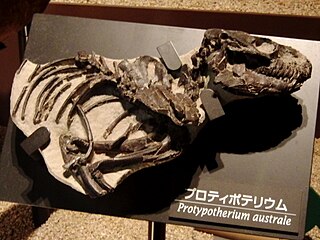
Interatheriinae is an extinct subfamily of interatheriids that consisted of notoungulates dating from the Early Eocene to the Early Pliocene. The subfamily includes the genera Archaeophylus, Argyrohyrax, Boleatherium, Brucemacfaddenia, Caenophilus, Choichephilum, Cochilius, Eopachyrucos, Federicoanaya, Interatherium, Juchuysillu, Miocochilius, Neoicochilus, Patriarchus, Proargyrohyrax, Progaleopithecus, Protypotherium, and Santiagorothia. They were small to medium sized interatheres, and when compared to the other subfamily, Notopithecinae, interatheriines are found to occupy an advanced, derived position in the family.














